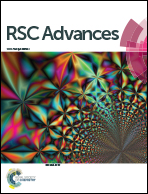Identification and pharmacokinetics of the major constituents of Fugan Fang in rat plasma†
Abstract
Fugan Fang (FGF) is an effective traditional Chinese medicine (TCM) prescribed for the clinical treatment of hepatic diseases. No reports exist on the absorbed bioactive components of FGF and their pharmacokinetics after oral FGF administration. In this study, the FGF components absorbed into the blood were identified and their pharmacokinetic profiles were explored, with the goal of understanding the effective constituents of FGF. Ultra-fast liquid chromatography-high resolution mass spectrometry techniques with a target-directed database-dependent strategy were used to identify the constituents of FGF extract and FGF compounds in rat plasma after oral FGF administration. Ultra-performance liquid chromatography coupled to triple-quadrupole mass spectrometry was used to evaluate the pharmacokinetics of several FGF compounds in rat plasma. A total of 53 compounds were present in the FGF extract, and 14 prototype constituents with 11 potential metabolites were identified in rat plasma. The pharmacokinetic parameters of calycosin-7-O-β-D-glucoside, ononin, gentiopicroside, sweroside, ferulic acid, and p-coumaric acid in rats were measured. These findings provide useful information that will support studies aimed at clarifying the identity of bioactive FGF constituents and their biological effects, and will thus further the development of FGF.


 Please wait while we load your content...
Please wait while we load your content...